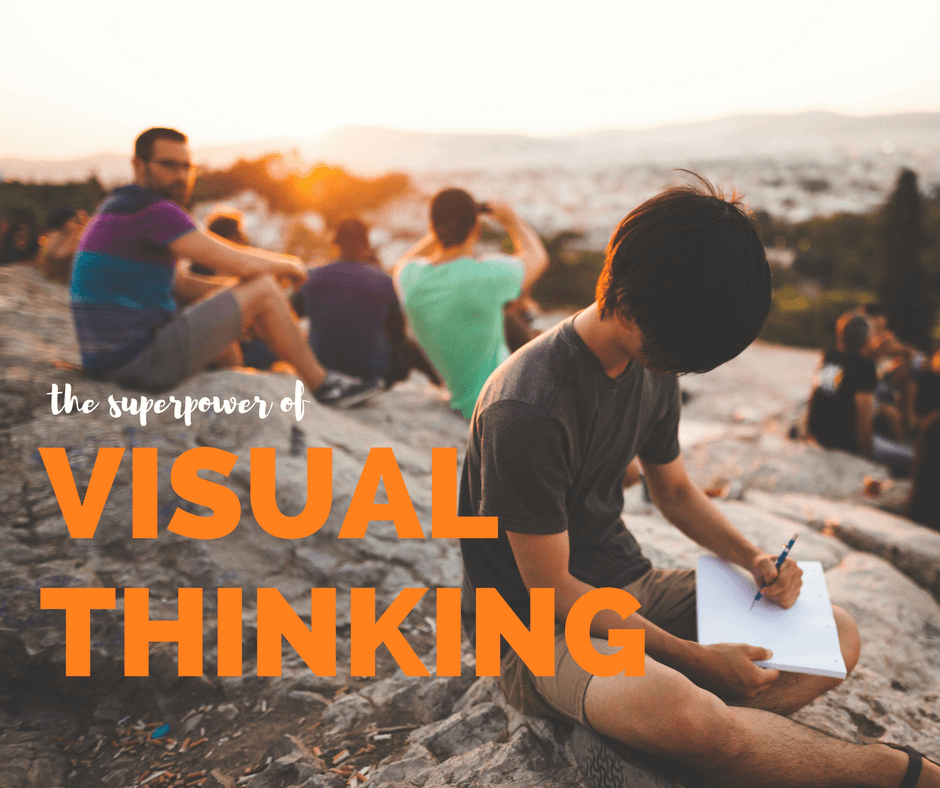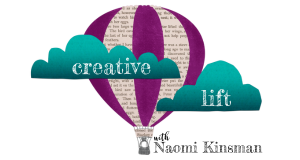
Visual thinking is a superpower that is often:
a. under utilized
or
b. completely ignored
Now, if you’re thinking–Visual thinking is for illustrators or architects, maybe for children, but not for me—stick with me for a moment. Growing up, I’ll bet that you struggled (at least a little) with either letters or numbers. If a teacher had allowed you to give up, saying, “I’m not a math person,” or “I simply can’t read,” you’d have breathed a sigh of relief at the time. But, consider what would have happened if you had opted out of math or reading and writing entirely. We know that the ability to think in numbers or to think in letters is key. However, somewhere along the way, we’ve forgotten the importance of thinking in images. We’ve allowed over half of the adult population to believe untruths such as, “I can’t draw.”
Why is visual thinking important?
Sunni Brown, author of the fantastic book, The Doodle Revolution, puts it this way: “A doodler is connecting neurological pathways with previously disconnected pathways. A doodler is concentrating intently, sifting through information, conscious and otherwise, and–much more often than we realize–generating massive insights.”
Howard Gardner identified visual intelligence as one of many intelligences. Linguistic intelligence and mathematical/logical intelligence are also on that list. It is true that different brains have different strengths. However, the fact that I don’t have a naturally mathematical brain does not negate my need to think and conceptualize in numbers. Linguistic skill is obviously key to my capacity as an author and the Executive Director of a literary nonprofit, but numbers are also a daily part of my work. I’m grateful for teachers who insisted I not give up on numbers simply because I did not have a strong inclination toward them.
The point is, many of us have decided we aren’t comfortable with visual thinking and thus, we’ve dismissed an entire literacy that could have been at our disposal. We’ve dismissed thinking in images because it is for other people or worse, childish. We’ve given ourselves permission to not conceptualize big ideas in sketch form, or via visual metaphor. We’ve limited our capacity for thinking big thoughts because … why? For most of us, it comes down to the ability to draw.
Most adults are afraid to draw.
Somewhere along the way, maybe in elementary school, someone pointed out that our horse didn’t really look like a horse. We noticed that our lines were wavy or our circles were lopsided. We expected ourselves to be photo-realistic artists, and for the most part, we expected this to happen instantly, magically, with no official training or concerted practice.
For the record, in order to think visually, you do NOT have to be an amazing artist. In fact, if you don’t want to, you never have to show your doodles to anyone else. However, I’d strongly, strongly encourage you to take a month and play around with doodling. See what comes out of it, and if you aren’t seeing results after giving it a real try, then let it go. My bet, though, is that you will be a visual thinking convert.
Visual thinking will help you in many ways.
If you’re willing to give this a go, I’d highly recommend your checking out Sunni Brown’s book. She provides research, inspiration for the mindset needed and practical strategies–everything you will need for your experiment. If you need a little nudge, though, here are some reasons why visual thinking will absolutely help you.
- When you draw, you externalize your thinking. We can only focus on a thought for a short amount of time before it is gone. Drawing a concept out on paper allows us to stick with the idea, to follow it where it leads.
- Images tap into figurative thinking. In order to make a concept, say freedom, into an image, we have to answer the question, What does freedom look like? This question, in and of itself, is useful as it brings new thinking to the table. When we nail down abstract thinking into concrete images, we start to see a path between our goal and what it might look like in real life.
- Images communicate quickly. There’s a reason for the explosion of infographics as of late. We can absorb information laid out in a combination of words and images much more quickly than we can read and comprehend long paragraphs (such as the paragraphs that make up this blog post, much to my chagrin)!
Need a tiny extra nudge?
Listen to your language over the next couple weeks. Notice if you use phrases such as, “I can’t see it happening,” or “If I could just see my workload,” or in response to a colleague’s idea, “What will that look like?” These phrases are clues that you are a visual thinker. You want to be able to mentally see something. Though your imagination is a strong tool for doing so, bringing that image out into the physical world will be even more inspirational. What you can imagine, you can draw. What you can draw, you can see. What you can see, you can make practical. And what you can make practical, you can make happen.
What does the superpower of visual thinking accomplish? Visual thinking will help you imagine ideas, see them, and bring them to life. Not too shabby as superpowers go, right?
My challenge to you is this:
Give yourself a month to play around with visual thinking. Use The Doodle Revolution if books help you explore new ideas. If not, simply take out pencil and paper and sketch the next time you’re planning or brainstorming. Conceptualize with a combination of words and images. Even when you don’t have pencil and paper in hand, play the “What does that look like?” game. Picture concepts such as creativity or hope in image form. Then, once you’ve played around, come back and share what you’ve noticed or learned. Or share with me on Facebook or Twitter. Let’s learn together! I can’t wait to chat with you. As you can probably tell, this is a subject of intense passion for me.
Here’s to you and your creative insights!
